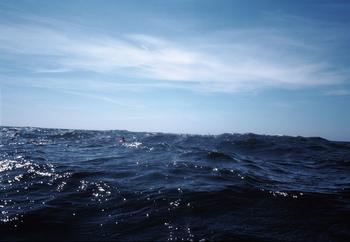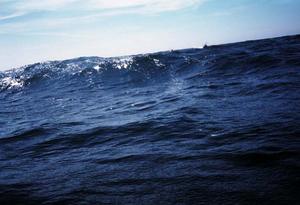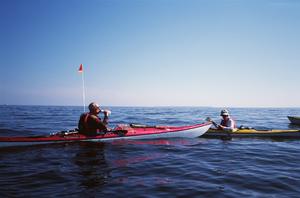

It was a wet trip from the very beginning. The waves
were sharp and splashing over the decks when we were
leaving the coast after the passport control. We
paddled slowly against the wind, water was slowly
oozing to my seat, and my woollen underwear was slowly
getting moistened.
I gave some warm thoughts towards my partner Rita who had patiently taken so many cold splashes of seawater against her face sitting at the front seat of our double during our expeditions. The news that that I would be having the same seat during a 30 km crossing to Naissaare and taking pictures had made her make some sarcastic remarks (between uncontrollable bursts of laughter) how I would be now tasting my own medicine.

The old flat freezer bottle, which had so faithfully
served me during many trips, was washed from the deck
during the first mile, and I did not even notice it. I
had not tied it to the deck bungies and I had to regret
my foolish decision. After a few minutes two small
plastic cider bottles filled with water were floating
by - someone else had suffered a similar loss. With my
paddling chump Markku, we saved the other to the front
deck.
No one seemed to be missing the bottles, though. Everyone was paddling patiently against the wind in the middle of elbow-high sharp waves and hot sunshine. It was the end of June and getting hotter and hotter after our start at 9 a.m.
I decided to save the cider bottles for later need, because I had made myself a new "energy drink" from seawater, juice and the water I had in my extra bottle. It tasted awful. Markku borrowed me a string to keep the bottle on deck.
We were all able to anticipate that the crossing was going to be a little bit rough, with sun and estimated gusts up to 11 m/sec (22 knots). Besides the obvious smell of neoprene, the air seemed to be full of testosterone we had only one female kayaker in our group. The fleet consisted of 22 singles and two double kayaks, plus a smallish 25-ft boat following us. Some of us had arrived to Porkkala peninsula late last night after a 40 km trip from the capital and we were now facing a 30 km (more than 16 nautical miles) crossing of open water and after a break at Naissaare a 25 km trip to Tallinn, the capital of Estonia. We were going to cross two busy boat routes heading to Helsinki and St. Petersburg at the east. Two groups of Estonian and Lithuanian competition paddlers were fighting over a prize of 1000 Euros somewhere south of us they had left the passport control in a rush when we were putting our small flotilla together.
We made our last landing to a small islet to relieve ourselves. The leader of this crossing Yrjo asked if someone was willing to turn back. No reaction everyone was willing to go.
When we were proceeding more towards the south, open sea and Naissaare Island the waves developed slowly something, which was estimated as 1,5-2 m (5ft, maximum of 7 ft) swells. Some of the tops were breaking slightly, but the wind was not anymore increasing itīs speed. The forecast had promised us 11m/s headwinds. It was getting hot; most of us were enjoying the sweaty safety of neoprene long johns and paddling jackets. An old lighthouse in the horizon to my right seemed to stay forever in the same place as if teasing me about our slow proceeding.
 After the first hour, two of the kayakers had capsized
in the waves. We had corrected our course and the waves
were now hitting the sides from SW. The rescuing
operation succeeded well and in good order: the kayaks
were put side by side, and the capsized paddler got
into his kayak feet first, climbing from the empty
space between the kayaks. In spite of the waves, the
emptying of a kayak with a hand pump seemed to go all
right. After a while, when we were paddling towards the
main group from the rescuing scene, we saw a white
bottom of a boat at our left. An older paddler, whose
foot braces were broken, had stayed close the safety
boat with the kayaker who was in charge of taking care
of the tail of the group. He probably capsized when he
was trying to get into the boat, or the small jolly
boat behind it. Because everything seemed to be under
control we paddled forwards and passed information
about the events to Yrjo. I noticed that my camera lens
was wet and tried to dry it with a small cloth. This
was definitely not the situation where I would like to
try to take out my other camera body, which was lying
in a waterproof bag under the spray-cover. I had
forgotten my wet woollen underwear a long time ago.
After the first hour, two of the kayakers had capsized
in the waves. We had corrected our course and the waves
were now hitting the sides from SW. The rescuing
operation succeeded well and in good order: the kayaks
were put side by side, and the capsized paddler got
into his kayak feet first, climbing from the empty
space between the kayaks. In spite of the waves, the
emptying of a kayak with a hand pump seemed to go all
right. After a while, when we were paddling towards the
main group from the rescuing scene, we saw a white
bottom of a boat at our left. An older paddler, whose
foot braces were broken, had stayed close the safety
boat with the kayaker who was in charge of taking care
of the tail of the group. He probably capsized when he
was trying to get into the boat, or the small jolly
boat behind it. Because everything seemed to be under
control we paddled forwards and passed information
about the events to Yrjo. I noticed that my camera lens
was wet and tried to dry it with a small cloth. This
was definitely not the situation where I would like to
try to take out my other camera body, which was lying
in a waterproof bag under the spray-cover. I had
forgotten my wet woollen underwear a long time ago.
I was getting worried together with Markku. The group was spread in the waves to a large area and seemed that the communication with the whistles was not possible anymore. What if there would happen several similar capsizes at the same time?
Later, weighing the situation, it has been considered that the dividing of the group into smaller cells happened at that time, during the first rescue operation. The navigator in the head of our flotilla was experienced but young kayaker, and he was not able to follow how the situation was developing behind him. The main group was also fighting the swells and anxious to proceed further, because the wind was pushing us back towards the coast and the Porkkala peninsula. The group started getting divided, first into two, then into smaller groups. Because of the time spent to the two first rescue operations the tail of the group was not able to inform the main group that it should wait and we all should get closer to each other.
The waves were hitting the kayak side now in direct angle of 90 degrees from the SSW. Later, during the afternoon the waves turned to hit the right back quarter, which seemed to be very uncomfortable to some kayakers. Aware of this, we started cruising in the middle of the main group and in the right, where some of the kayakers were keeping their bows slightly towards the wind in a much more comfortable angle. This felt surely safer to some, but it was also leading some of the paddlers out of range of whistles or possible hand signs. They were in danger and we had to paddle up there several times to remind them.
We, Markku and I, rescued the kayaker who had capsized first three times during that afternoon. He seemed to have a lot of trouble with the stability in his plastic single, which was noticeable too light. First we used the method described above, with the hand pump, but the pumping seemed to take a lot of time and precious energy even if there was two people taking turns at pumping. The next two rescues were modified x-rescues, where the bow of the light but water-filled kayak was only slightly taken onto the deck of our supporting double, just to let the water out from the cockpit. We finished the rescue with the hand-pump, after the capsized kayaker had climbed back to his single from the space left between the kayaks. I was keeping the bows towards the waves and supporting with the stability, and Markku was giving directions behind my back and helping this mate to finish with his pumping. We paid some attention towards giving him time to rest and refuel. A kayaker with stability troubles has most probably very little time and possibilities to enjoy energy bars and even fresh water during a long crossing.
 Later we found a kayaker who had lost all his water
bottles and had paddled more than an hour without any
refuelling. We gave him the above mentioned water
bottle, which we had found. After more than five or six
hours, after we had crossed the busy boat routes with
several merchant vessels and a small tanker passing by,
we got finally a sight of the Naissaare lighthouse in
the horizon. When we were getting closer the coast the
swells finally seemed to calm down a little. The group
had divided into small cells, but the crossing of the
routes had gone well. Still, two paddlers were heading
slightly to the right, but we did now only keep an eye
for them. We had had enough of all this nursing and
they were within our reach.
Later we found a kayaker who had lost all his water
bottles and had paddled more than an hour without any
refuelling. We gave him the above mentioned water
bottle, which we had found. After more than five or six
hours, after we had crossed the busy boat routes with
several merchant vessels and a small tanker passing by,
we got finally a sight of the Naissaare lighthouse in
the horizon. When we were getting closer the coast the
swells finally seemed to calm down a little. The group
had divided into small cells, but the crossing of the
routes had gone well. Still, two paddlers were heading
slightly to the right, but we did now only keep an eye
for them. We had had enough of all this nursing and
they were within our reach.
Finally, after 9 hrs of paddling instead of normal 6 to 7 hrs, we landed the beach where the water was almost calm. One by one, back and thighs aching, face slightly burnt and bladder ready to burst, we tried to walk. Some of the paddlers fell down at the waterline. They had no feeling in their legs. It felt nice, though. Everything had gone all right in spite of disorganisation and I had hot chocolate mixed with strong coffee in my thermos waiting for me. I was not totally satisfied, though. When I was walking inland to relieve myself, I did find out that there was a certain angry species of yellow ants, which had settled in the woods, and ouch- they were really angry and willing to bite

A helicopter was flying slowly over the beach and three
frontier guard officers were waiting for us to check
the passports. Only the day after, when we paddled to
the capital, Tallinn in a calm and hot weather, we
found out at the harbour that two of the competition
kayakers had capsized. The other one was still in
hypothermic condition. What the frontier guards had
also not told us, was that from the both sides of the
Finnish Gulf the officials had launched a massive
search operation because of us. Somewhere, somehow,
after receiving the message that there was two paddlers
in water, one in front of the Tallinn lighthouse and
the other in front of the Naissaare island, they had
mistaken us all as a one group. The competition
paddlers were ill equipped, some of them wearing only
t-shirts or sport jackets under their pfdīs.
When we were heading back to Helsinki by ferry next night we were already in the news.